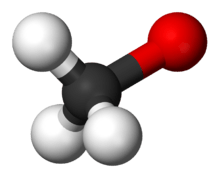Sodium methoxide
| | |||
| |||
| Names | |||
|---|---|---|---|
| IUPAC name
Sodium methoxide | |||
| Other names
Sodium methylate | |||
| Identifiers | |||
| 124-41-4 | |||
| 3D model (Jmol) | Interactive image | ||
| ChemSpider | 29033 | ||
| ECHA InfoCard | 100.004.273 | ||
| PubChem | 10942334 | ||
| UNII | IG663U5EMC | ||
| |||
| |||
| Properties | |||
| CH3NaO | |||
| Molar mass | 54.02 g/mol | ||
| Appearance | White solid | ||
| Melting point | 127 °C (261 °F; 400 K) | ||
| Boiling point | > 300 °C (572 °F; 573 K) | ||
| Solubility | Soluble in ethanol, methanol Insoluble in hydrocarbons | ||
| Structure | |||
| Hexagonal | |||
| Hazards | |||
| EU classification (DSD) |
Harmful (Xn), Corrosive (C) | ||
| Except where otherwise noted, data are given for materials in their standard state (at 25 °C [77 °F], 100 kPa). | |||
| | |||
| Infobox references | |||
Sodium methoxide is a chemical compound with the formula CH3ONa. This colorless solid, which is formed by the deprotonation of methanol, is a widely used reagent in industry and the laboratory. It is also a dangerously caustic base.
Preparation and structure
Sodium methoxide is prepared by carefully treating methanol with sodium:
- 2 Na + 2 CH
3OH → 2 CH
3ONa + H
2
The reaction is so exothermic that ignition is possible. The resulting solution, which is colorless, is often used as a source of sodium methoxide, but the pure material can be isolated by evaporation followed by heating to remove residual methanol. The solid hydrolyzes in water to give methanol and sodium hydroxide; commercial-grade product can be contaminated with the hydroxide. The solid and especially solutions absorb carbon dioxide from the air, thus diminishing the effectiveness of the base.
In the solid form, sodium methoxide is polymeric, with a sheet-like arrays of Na+ centers, each bonded to four oxygen centers.[1]
The structure, and hence its basicity, of sodium methoxide in solution depends on the solvent. It is a significantly stronger base in DMSO where it is more fully ionized and free of hydrogen bonding.[2]
Applications
Organic synthesis
Sodium methoxide is a routinely used base in organic chemistry, applicable to the synthesis of numerous compounds, ranging from pharmaceuticals to agrichemicals.[2] As a base, it is employed in dehydrohalogenations and various condensations.[3] It is also a nucleophile for the production of methyl ethers.[4]
Industrial applications
Sodium methoxide is used as an initiator of anionic addition polymerization with ethylene oxide, forming a polyether with high molecular weight. Biodiesel is prepared from vegetable oils and animal fats, that is, fatty acid triglycerides, by transesterification with methanol to give fatty acid methyl esters (FAMEs). This transformation is catalyzed by sodium methoxide.
Safety
Sodium methoxide is highly caustic, and the hydrolysis gives methanol, which is toxic and volatile.
NFPA 704
The ratings for this substance vary widely.
| Rating | |||||
|---|---|---|---|---|---|
| Source | State of Connecticut[5] | DuPont[6] | Pharmco AAPR[7] | ScienceLab[8](Both ratings on same sheet) | |
See also
References
- ↑ E. Weiss (1964). "Die Kristallstruktur des Natriummethylats" [The Crystal Structure of Sodium Methylate]. Zeitschrift für Anorganische und Allgemeine Chemie (in German). 332 (3–4): 197–203. doi:10.1002/zaac.19643320311.
- 1 2 Y. El-Kattan; J. McAtee; B. Bessieres (2006). "Sodium Methoxide". Encyclopedia of Reagents for Organic Synthesis. New York: John Wiley & Sons. doi:10.1002/047084289X.rs089m.pub2.
- ↑ O. E. Curtis, Jr., J. M. Sandri, R. E. Crocker, H. Hart (1958). "Dicyclopropyl ketone". Org. Synth. 38: 19. doi:10.15227/orgsyn.038.0019.; Coll. Vol., 4, p. 278
- ↑ F. Reverdin (1927). "3,5-Dinitroanisole". Org. Synth. 7: 28. doi:10.15227/orgsyn.007.0028.; Coll. Vol., 1, p. 219
- ↑ "The Code Officials Perspective" (PDF).
- ↑ "DuPont Material Safety Data Sheet" (PDF).
- ↑ "Pharmco AAPR Material Safety Data Sheet" (PDF).
- ↑ "ScienceLab Material Safety Data Sheet".


